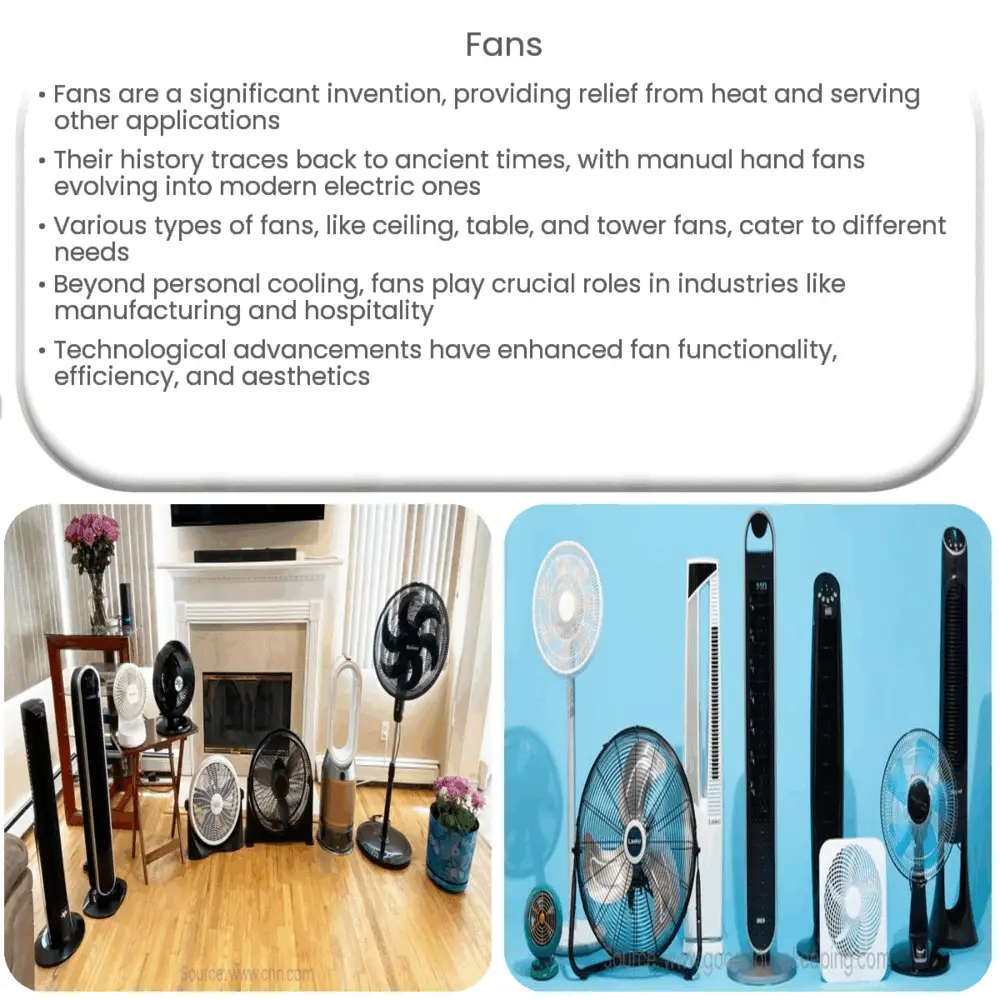Explore the history, types, and advancements of fans, their role in various industries, and their impact on aesthetics and the environment.

Fans: An Essential Invention
Fans are one of the most simple yet remarkable inventions of humankind. Used widely across the globe, their significance is not only in providing relief from the heat but also in a myriad of other applications. Let’s explore the journey of fans throughout history, their types, and the pivotal role they play in our daily lives.
A Brief History of Fans
Historically, the use of fans can be traced back to the ancient times. They were often symbols of royalty, with 1 pharaohs in Egypt, emperors in China, and kings in Europe being portrayed with fans. However, these were not the mechanical fans we know today but rather manual hand fans made from palm leaves, feathers, or silk. The industrial revolution in the 19th century paved the way for the creation of the electric fan, making it a common household item.
Types of Fans
-
Ceiling Fans: These are the most common types of fans seen in households and offices. Ceiling fans help circulate the air within a room, providing a cooling effect.
-
Table Fans: Compact and portable, table fans are versatile and can be placed on desks, tables or any flat surface. They are an ideal choice for personal cooling.
-
Tower Fans: Tower fans are sleek, space-saving fans that provide effective cooling in larger areas. They often come with features such as timers and remote controls for added convenience.
The Role of Fans in Various Industries
Fans are not just used for personal cooling but also play a crucial role in various industries. In the manufacturing sector, industrial fans are used for ventilation and to control the temperature and humidity. Fans are also used in computers and other electronic devices to cool down the components and prevent them from overheating. In the hospitality sector, fans add to the aesthetics of the interior design while also maintaining a comfortable temperature.
Whether it’s a scorching summer day or a device running at full capacity, fans serve a fundamental purpose. Their design and technology have evolved significantly over time, making them an indispensable part of our lives.
Advancements in Fan Technology
Technological advancements have led to significant improvements in the functionality and efficiency of fans. Modern fans are equipped with features like energy-saving modes, sleep timers, and remote controls for ease of use. Additionally, the advent of ‘smart fans’ allows users to control fan operations through mobile applications or voice commands, integrating them with other smart home devices.
Fans and Environmental Impact
While fans consume significantly less energy compared to air conditioners, it’s worth noting the ongoing efforts to make fans even more energy-efficient. Many manufacturers are striving to design fans that consume less electricity, contributing to a greener environment. Such energy-efficient fans, coupled with the use of renewable energy sources, can substantially reduce the carbon footprint of our cooling needs.
The Aesthetics of Fans
In addition to their practicality, fans have also evolved to become aesthetic elements in room decor. From vintage-looking ceiling fans that add a rustic charm to sleek, modern designs that complement contemporary interiors, fans today are as much about style as they are about cooling.
-
Vintage fans: These are often designed with a classic touch, reminiscent of a bygone era. They are a perfect choice for spaces designed with a vintage or rustic theme.
-
Modern fans: These fans come with sleek designs and a variety of color options. They can blend seamlessly with contemporary decor.
-
Custom fans: For those who prefer a unique touch, some manufacturers offer custom fans that can be designed according to individual preferences.
Conclusion
In conclusion, fans are an integral part of our lives. From their humble beginnings as hand-operated devices to the high-tech, energy-efficient models of today, fans have come a long way. Their application in various industries highlights their importance beyond personal use. Furthermore, advancements in fan technology have not only improved their efficiency but also turned them into aesthetic elements that can enhance the look of a space. As we continue to strive for sustainable living, the humble fan stands as a testament to the balance between practicality, design, and environmental consciousness.

